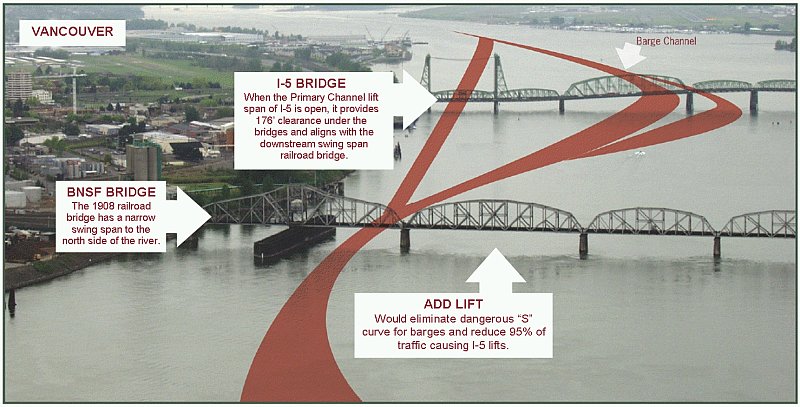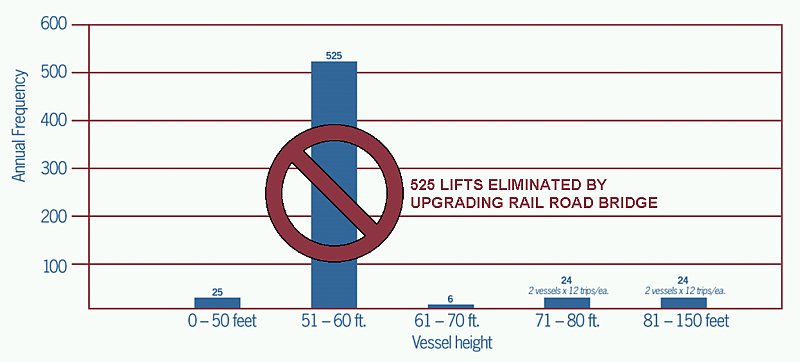The BNSF Railroad Bridge offers a better solution.
click
 for link to related website
for link to related websiteclick
 for link to source document
for link to source documentclick
 for link to video
for link to videoBy resurrecting the 2004 "Vancouver BNSF Rail Bridge Project" the only "stop-light" on I-5 would be nearly eliminated.
Benefits of the "Vancouver BNSF Rail Bridge Project"
• It's a bargain - Estimated cost of $42 million in 2004
• Over 90% of I-5 bridge lifts would be eliminated
• Eliminates the dangerous "S" maneuver for barges
• Wider clearance for all river users
• Improved river safety for barges
• Coast Guard compliant
• No negative impacts on businesses or properties
• Will benefit any future I-5 bridge design
• Faster BNSF bridge open/close recovery for rail users
• It's a fast project - The same project was done in 1989 on the same rail line over the Willamette River and the rail line was only down an amazing 72 hours due to off-site pre-fab design of the lift section.

The current problem:
In Short: The railroad bridge is a swing bridge, but the swing is aligned with the lift section of the I-5 bridge. If the railroad bridge was updated with a middle lift, barges could pass under tall south side section of I-5 without traffic causing lifts.
In Detail: When the Primary Channel lift span of I-5 is open, it provides the tallest clearance (179') under the bridges and aligns with the swing span of the downstream 104 year old railroad bridge. When the lift span is closed the tallest clearance is at the Barge Channels (72'). When using the Barge Channels, vessels must navigate an "S" curve between the I-5 Bridge and swing span of the Railroad Bridge. Captains most often use the Primary Channel because the "S" curve maneuver used to avoid lifts is considered one of the most dangerous maneuvers on the Columbia River. Thus, the Railroad Bridge causes most traffic causing I-5 bridge lifts.


More on the "Vancouver BNSF Rail Bridge Project"

• Summary by METRO JPAC in 2004 on the project

• Frequently Asked Questions about the Vancouver BNSF Rail Bridge Project by the CFO of Bernert Barge Line, Inc.

• Highway Benefits of Relocating the Movable Span on the Vancouver Rail Bridge

• Comment on Freight Priorities by Chairman of the Columbia River Towboat Association

• Currently, the BNSF Rail Bridge presents an unreasonable obstruction to navigation with a horizontal clearance of 200 feet vs. 600 feet found in each direction from the rail bridge.

What about high-speed rail?
• Pacific Northwest corridor has received about $1.5 billion dollars in federal funding for rail improvements.

• Amtrak and California Rail Authority will join forces for high-speed rail.

• A plan like the Cascadia Multi-Modal Bridge will accommodate BNSF/UNP rail freight, commuter and high speed rail and motor vehicles for a fraction of the cost with far less impacts.
